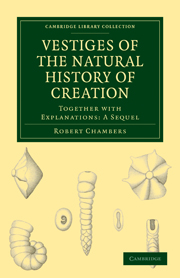Book contents
- Frontmatter
- Contents
- THE BODIES OF SPACE—THEIR ARRANGEMENTS AND FORMATION
- CONSTITUENT MATERIALS OF THE EARTH, AND OF THE OTHER BODIES OF SPACE
- THE EARTH FORMED—ERA OF THE PRIMARY ROCKS
- COMMENCEMENT OF ORGANIC LIFE—SEA PLANTS, CORALS, ETC
- ERA OF THE OLD RED SANDSTONE—FISHES ABUNDANT
- SECONDARY ROCKS—ERA OF THE CARBONIFEROUS FORMATION—COMMENCEMENT OF LAND PLANTS
- ERA OF THE NEW RED SANDSTONE—TERRESTRIAL ZOOLOGY COMMENCES WITH REPTILES—FIRST TRACES OF BIRDS
- ERA OF THE OOLITE—COMMENCEMENT OF MAMMALIA
- ERA OF THE CRETACEOUS FORMATION
- ERA OF THE TERTIARY FORMATION — MAMMALIA ABUNDANT
- ERA OF THE SUPERFICIAL FORMATIONS—COMMENCEMENT OF PRESENT SPECIES
- GENERAL CONSIDERATIONS RESPECTING THE ORIGIN OF THE ANIMATED TRIBES
- PARTICULAR CONSIDERATIONS RESPECTING THE ORIGIN OF THE ANIMATED TRIBES
- HYPOTHESIS OF THE DEVELOPMENT OF THE VEGETABLE AND ANIMAL KINGDOMS
- AFFINITIES AND GEOGRAPHICAL DISTRIBUTION OF ORGANISMS
- EARLY HISTORY OF MANKIND
- MENTAL CONSTITUTION OF ANIMALS
- PURPOSE AND GENERAL CONDITION OF THE ANIMATED CREATION
- NOTE CONCLUSORY
- APPENDIX
CONSTITUENT MATERIALS OF THE EARTH, AND OF THE OTHER BODIES OF SPACE
Published online by Cambridge University Press: 05 August 2011
- Frontmatter
- Contents
- THE BODIES OF SPACE—THEIR ARRANGEMENTS AND FORMATION
- CONSTITUENT MATERIALS OF THE EARTH, AND OF THE OTHER BODIES OF SPACE
- THE EARTH FORMED—ERA OF THE PRIMARY ROCKS
- COMMENCEMENT OF ORGANIC LIFE—SEA PLANTS, CORALS, ETC
- ERA OF THE OLD RED SANDSTONE—FISHES ABUNDANT
- SECONDARY ROCKS—ERA OF THE CARBONIFEROUS FORMATION—COMMENCEMENT OF LAND PLANTS
- ERA OF THE NEW RED SANDSTONE—TERRESTRIAL ZOOLOGY COMMENCES WITH REPTILES—FIRST TRACES OF BIRDS
- ERA OF THE OOLITE—COMMENCEMENT OF MAMMALIA
- ERA OF THE CRETACEOUS FORMATION
- ERA OF THE TERTIARY FORMATION — MAMMALIA ABUNDANT
- ERA OF THE SUPERFICIAL FORMATIONS—COMMENCEMENT OF PRESENT SPECIES
- GENERAL CONSIDERATIONS RESPECTING THE ORIGIN OF THE ANIMATED TRIBES
- PARTICULAR CONSIDERATIONS RESPECTING THE ORIGIN OF THE ANIMATED TRIBES
- HYPOTHESIS OF THE DEVELOPMENT OF THE VEGETABLE AND ANIMAL KINGDOMS
- AFFINITIES AND GEOGRAPHICAL DISTRIBUTION OF ORGANISMS
- EARLY HISTORY OF MANKIND
- MENTAL CONSTITUTION OF ANIMALS
- PURPOSE AND GENERAL CONDITION OF THE ANIMATED CREATION
- NOTE CONCLUSORY
- APPENDIX
Summary
The nebular hypothesis necessarily supposes matter to have originally formed one mass. We have seen that the same physical laws preside over the whole. Are we also to presume that the constitution of the whole was uniform?—that is to say, that the whole consisted of the same elements. It seems difficult to avoid coming to this conclusion, at least under the qualification that, possibly, various bodies, under peculiar circumstances attending their formation, may contain elements which are wanting, and lack some which are present, in others, or that some may entirely consist of elements in which others are entirely deficient.
What are elements? This is a term applied by the chemist to a limited number of substances, (fifty-four or fifty-five are ascertained,) which, in their combinations, form all the matters present in and about our globe. They are called elements, or simple substances, because it has hitherto been found impossible to reduce them into others, wherefore they are presumed to be the primary bases of all matters. It has, indeed, been surmised that these so-called elements are only modifications of a primordial form of matter, brought about under certain conditions; but if this should prove to be the case, it would little affect the view which we are taking of cosmical arrangements. Analogy would lead us to conclude that the modifications of the primordial matter, forming our so-called elements, are as universal, or as liable to take place everywhere, as are the laws of gravitation and centrifugal force.
- Type
- Chapter
- Information
- Vestiges of the Natural History of CreationTogether with Explanations: A Sequel, pp. 29 - 45Publisher: Cambridge University PressPrint publication year: 2009First published in: 1844



